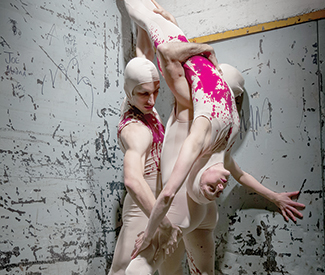arts@sfbg.com
DANCE With three world premieres in its recent Spring Home Season performances, Hope Mohr Dance gave the audiences pieces that were both opaque and transparent. They were opaque because their physical imagery contained narrative traces that resonated beyond the stage, but was often equally focused on a gesture’s physicality in the moment. They were transparent because of the clarity and intensity that these fabulous dancers brought to their tasks. Their presence burnt itself into your retina and your soul. Any way you want to take this, Hope Mohr Dance is a head trip these days.
For Route 20, Connie Strayer put Jeremy Bannon-Neches, James Graham, and Tegan Schwab into off-white, hooded unitards. It made the dancers look like robotic extraterrestrials, except that the red streaks on their bodies suggested freshly spilled blood. Given enough time, designer David Szlasa’s dripping block of ice, which encased some dark mystery, might have revealed its secrets.
While the body suits encouraged seeing the dancers as gender-neutral — a hopeless task as far as I am concerned — the choreography treated the three performers as equals. The tension, such as it was, seemed to be based more on an inherent lack of stability within the triangle than on any specific movement patterns. It allowed for a constant flow of interactions without much emotional baggage. Abrupt turns, collapsing torsos, and dancers jumping on each other and being carried aloft felt neutral. The music’s brilliant pointillism seemed to encourage the lack of a clear trajectory in favor of an intense presence. And yet there were moments — the ice melting? — when Mohr’s neutral beings became more individualized. When Schwab streaked between the two men, was she breaking something up? When two dancers held on to each other at arms’ length, was one of them looking into a mirror? Repeatedly, a nuzzling gesture suggested skin-on-skin contact.
There are moments in ridetherhythm, a sextet for which theater director Mark Jackson signed on as dramaturge, when the work approached pure music in the way fractured language rose into a chorus to retreat again into individual voices. Fragments of text flew from dancer to dancer, and countdown patterns became threatening even as they tried to impose a sense of order. It’s rare that dancers become truly expert at delivering words and movement; Mohr’s troupe was first-rate in both.
The choreographer went for inspiration to Anne Carson’s Antigonick, the poet’s translation of Sophocles’ play, and to Todd Haynes’ 1995 Safe, in which Julianne Moore plays a housewife trapped in a poisonous environment. Katharine Hawthorne, in a beautifully subtle performance that ebbed and swelled, was the woman who went her own way despite the fact that she lived in a man’s world. When she fell, Schwab threw herself on top of her, in what was perhaps the work’s single most touching moment. The narrative emerged only in bits and pieces, but Mohr’s ability to suggest a pervading doom, despite Evan Johnson’s soothsaying along the lines of “everything is all right, we are safe,” and “he’s a jolly good fellow,” was impressive. In one spot, the group’s search for an oasis of safety was almost comical, and when the dancers kneeled you didn’t know whether they did so in despair or with hope.
I never could figure out the work’s connection between Hegel, Beckett, and Sophocles. But then Megan Brian, a character in high heels and sunglasses who tried to bring order into the chaotic proceedings by obsessively writing down whatever she saw — not unlike some dance critics — finally threw in the towel. ridetherhythm clearly warrants repeated viewing.
Exuberant and yet ever so controlled, Notes Toward a Supreme Fiction was a two-way street in terms of improvisation. Here the musicians — Michael Coleman on keyboard, Henry Hung on trumpet, Tommy Folen on bass, and Gerald Patrick Korte on percussion — responded as much to the dancers as the other way around. For this choreography the excellent Lindsey Renee Derry, Roche Janken, and David Schleiffers joined Bannon-Neches, Graham, and Schwab, who also individualized the dancers with color-saturated tank tops.
Schwab and Hung engaged each other in a playful duet, while Folen’s bass sent Bannon-Neches into spasmodic travels. Graham at one point strode upstage with every part of his torso alive to the music. I don’t know whether his greeting of dancers was a spur of the moment idea but it felt right on.
While some sections — unisons for instance — served as time markers and probably were planned, a duet between Schwab and Janken, for instance, could have been improvised. It was important that spontaneity blossomed within given parameters, sometimes determined by simple commands like “stop” and “go.” With Szlasa favoring slightly dimmed houselights, thus suggesting the breaking of the fourth wall, Notes came to look like a spacious and airy informal get-together. I kept thinking of watching outdoor ice skaters on a sunny afternoon. *

